Seminar on the Evidence of Manuscripts (August 1994)
September 7, 2016 in Manuscript Studies, Seminars on Manuscript Evidence
“Medieval Manuscript Fragments:
A Seminar”
Parker Library
15 August 1994
In the Series of Seminars on “The Evidence of Manuscripts”
The Parker Library, Corpus Christi College, Cambridge
Invitation in pdf, with 2-Page Invitation Letter and 1-page RSVP Form
The previous Seminar in the Series considered
“Marginalia in Manuscripts”
(Parker Library, 24 June 1994).
[First published on 6 September 2016]
This seminar was “devoted to medieval manuscript fragments at the Parker Library and elsewhere, in both public and private collections.” As usual, the existence of manuscripts in other collections relevant to the theme under consideration was taken into account, but now, thanks to their collector, our Associate Toshiyuki Takamiya, some of those manuscripts came to the Library for Seminar to see and to compare.
[Update in September 2017: See the end of this post for news about the Takamiya Collection now at the Beinecke Rare Book and Manuscript Library.]
The Plan
The 2-page Invitation Letter (both shown here and downloadable here with its RSVP Form) presents the plan:
This will consider the myriad problems and challenges of manuscript fragments: their discovery, rediscovery and recovery; their present contents, both original and acquired; their states and locations, both present and past; their contexts (present, intermediary and original); their handling and conservation; the identification of their texts; assessment of their dates, origins and provenance; and reconstruction of their original manuscripts.
For the first time in the Series, manuscript materials not belonging to Corpus Christi College would be brought to the table.
For the seminar Toshiyuki Takamiya will bring from Japan some examples of Western manuscript fragments in his own collection. Beforehand these will be deposited in the Parker Library for a period of consultation, photography and image-enhancement of damaged and mostly illegible passages by members of the Research Group and other speakers.
The Speakers and Subjects
Nigel Wilkins will speak about musical manuscript fragments and elsewhere (for example in Corpus MSS 8 and 233), including some new discoveries.
R.I. Page will consider an Anglo-Saxon fragment from Westminster.
Mildred Budny will survey Anglo-Saxon and Irish manuscript fragments at Corpus, including those comprising MSS 197B, 214 and 557 and those contained in MSS 111, 144, 270 and 321, together with the burnt or displaced fragments in the British Library from the same manuscript as MS 197B (Cotton MS Otho C.v plus two leaves in Royal MS 7 C.xii, folios 2–3).
David Ganz will remark on the surviving fragments of a glossed Anglo-Saxon or Continental manuscript of the Aeneid, including its portion discovered in an early printed book at Corpus (EP–O–6).
Nicholas Hadgraft and Tony Parker will assess the problems of handling and conserving manuscript fragments.
Toshiyuki Takamiya will speak about the joys and challenges of collecting manuscript fragments.
Richard Marsden will discuss the early biblical fragments in the Takamiya collection.
Andrew Prescott will consider a pontifical fragment in the same collection.
Simon Keynes might be able to attend to discuss the challenges of rediscovering, examining, deciphering, identifying and assessing manuscript fragments, focusing upon British Library, Cotton MS Otho A.i (badly damaged by fire in 1731), from which another (undamaged) leaf survives in Oxford, Bodleian Library, MS Arch Selden B.26 (3340), folio 34.
And there’s more.
Besides the Takamiya fragments, a group of volumes in the Corpus collection will be available for examination during the seminar. Among them will be fragments of various kinds considered by the speakers. Other volumes may emerge for inspection in the course of the session.
And so we set to work.
*****
An Aside:
How Fortunate That Some Fragments of Dispersed Manuscripts Escaped the Fire
And That Some Elements Before the Fire Were Reproduced
Such escape was the case with some detached leaves with parts of the prefatory Eusebian Canon Tables from the same Insular Gospel Book as the Cambridge–London Gospels. Now part of Royal MS 7 C.xii, they were removed from the book well before the Cotton Fire of 1731, which badly damaged the portions of Matthew and Mark in Cotton MS Otho C.v.
The Corpus portions of John and Luke (in that order) had been separated from the original manuscript before that fragment came to Matthew Parker, who died in 1575, also long before the fire. However, Parker, who entered the page numbers and an attributing inscription upon its pages, had the Gospel fragment rebound. In the process, its edges suffered trimming, with the losses of some original script and decoration. Boo Hoo!
A set of 18th-century antiquarian reproductions of elements of the Cotton portion were made while it was still unburnt. It belongs to a collection of specimens assembled by Thomas Astle for his book on The Origin and Progress of Writing (1784). Preserved also at the British Library (Stowe MS 1061), and shown here, the samples of script and decorated lettering in the Cotton portion of the Gospel Book offer glimpses of the original across time and Once-Upon-A-Time, albeit in antiquarian and somewhat self-conscious fashion. The array of specimens on the antiquarian page resemble the approach of a scrapbook.
A similar antiquarian reproduction, spread over 4 quarto-sized pages of coloured plates in print, addressed portions of script, decoration, and illustration in the Corpus portion of the same manuscript. It was the work of the Rev. James Goodwin, Fellow of Corpus Christi College, for An Historical and Illustrative Description of the MSS. No. CCLXXXVI. and No. CXCVII. in the Parker Library of Corpus Christi College, Cambridge (1847), plates VIII – XI. But those plates, because the original remains more-or-less unscathed (page-trimming notwithstanding), retain their antiquarian interest, rather than acquiring the stature of a primary witness to the monument, albeit after the fact, as in the case of Thomas Astle’s poignant images from the Cotton portion.
The result over time and through the assaults by knife, by dispersal, and by fire yield Scraps of manuscripts and of pre-photographic reproductions of manuscripts. Scraps of Books. Better than nothing!
*****
Participants
Invitations sent to:
R.I. Page, Mildred Budny, Nigel Wilkins, Tim Graham, Leslie French, Catherine Hall, Nicholas Hadgraft, Tony Burne, Mel Jefferson, Alan Farrant, Simon Keynes, Andrew Prescott, Tony Parker, Toshiyuki Takamiya, David Ganz, Richard Marsden, Bob Proctor, Annie Winklar, Joyce Hill, Don Scragg, Raymond Grant, Malcolm Godden, Michael Borrie, Stephanie Kenna, Nigel Ramsay, Michael Gullick, Tessa Webber, Nigel Ramsay, James P. Carley, Sue Hitch, Rohini Jayatilaka, Rowan Watson, Joan Lazenby, Kate Lowe, Graham Woan, Shinsuke Ando, Emiko Kinebuchi, Chieko Hirose
Present (according to a set of annotated notes in our Research Group Archives, along with the completed RSVP forms as returned):
R.I. Page, Mildred Budny, Nigel Wilkins, Tim Graham, Leslie French, Catherine Hall, Nicholas Hadgraft, Tony Burne, Mel Jefferson, Alan Farrant, Simon Keynes, Andrew Prescott, Tony Parker, Toshiyuki Takamiya, David Ganz, Richard Marsden, Bob Proctor, Annie Winklar, Joyce Hill, Don Scragg, Malcolm Godden, Michael Borrie, Nigel Ramsay, Michael Gullick, James P. Carley, Sue Hitch, Rowan Watson, Joan Lazenby, Anthony Hugget, Taki Takeuchi, Emiko Kinebuchi, Chieko Hirose, Brigitte Schliedemann, Karen Parhau
In the spirit of the event, Nicholas Hadgraft made a fresh set of chopped fragments from the first sheet of the photocopied paper handout showing some musical fragments. The Research Group Archives preserves them, along with the folder of correspondence, preliminary notes, handouts as distributed on the day, and a set of handwritten notes taken on the day.
Party
The Seminar was followed by a Party, hosted by the Librarian, Nigel Wilkins, and Mildred Budny, with Wine and Cheese in Room P3 (Old Court).
*****
Report
An detailed, unnumbered 16-page handwritten report by Mildred Budny survives in the Research Group Archives. Comprising a form of notes in pencil on the day, this text mainly reports the sequence and contents of the presentations and discussions. It also cites the other mentioned manuscripts, at Corpus (for example, MS 145, 459, 102, 104, 105, 109, 120, 130) and elsewhere (London, Paris, Brussels).
*****
Suggestions for Further Reading
Some publications relate to the fragments under inspection either directly or at a distance. Here are a few by speakers at the seminar or others.
The Takamiya Collection
- Toshiyuki Takamiya, “A Handlist of Western Medieval Manuscripts in the Takamiya Collection”, in The Medieval Book: Glosses from Friends and Colleagues of Christopher de Hamel, edited by J.H. Marrow, Richard Linenthal, and Will Noel (2010), 421–440.
Cotton MS Otho A I
Made in the 8th century in Southern England, the manuscript contains decrees of the Council of Clofesho (747 CE); a charter of Æthelbald, king of Mercia, of 749 CE [= Sawyer Number 92]; and extracts of the Regula pastoralis by Pope Gregory the Great. The volume was much damaged by fire.
- Simon Keynes, “The Reconstruction of a Burnt Cottonian Manuscript: The Case of Cotton MS Otho A.i, “British Library Journal (1996), 113–149
Corpus Christi College, MS 557 (2 fragments of the same leaf)
These 2 fragments, which came from a single leaf, were recovered from the bindings of 2 different early printed books (SP–260 and SP–4). They and a companion leaf now in Lawrence, Kansas (University of Kansas, Pryce MS C2:1) came from one manuscript containing a homily on “The Finding of the True Cross” and bearing annotations by the 13th-century “Tremulous Worcester Hand”.
- R.I. Page, Mildred Budny and Nicholas Hadgraft, “Two Fragments of an Old English Manuscript in the Library of Corpus Christi College, Cambridge”, Speculum, 70:3 (1995), 502–529
Westminster Abbey Muniments, 67209 (a binding fragment with parts of a homily)
This “strip of parchment sliced from an Old English manuscript, perhaps to be dated to the first half of the eleventh century”, may have served as “some sort of book mark”, or, as “Andrew Prescott of the British Library suggests[,] it was the stop of a string used to thread together bundles of documents” — to quote its printed report (cited here, page 289).
- R.I. Page, “An Old English Fragment from Westminster Abbey”, Anglo-Saxon England, 25 (1995), 289–294
Corpus Christi College, EP–O–6 (binding strip)
This Latin fragment of the Aeneid was found in reused position at the back of the binding of Corpus Christi College, E[arly]P[rinted]–O–6. The volume is an early printed book of Cyrurgia variorum printed in Venice in 1519, but it was bound by a binder active in London in the 1530s and 1540s, to judge by the roll-stamps used on the binding. The narrow vertical fragment contains parts of Aeneid, Book V, lines 458–491 and 492–523 (as identified by Tim Graham).
Other fragments from the same glossed medium-format manuscript, probably made on the Continent in the 9th or 10th century, survive with parts of the Aeneid and the Georgics, so it was a copy of Vergil’s works, or some of them. Other fragments (as David Ganz recognised) are known in Deene Park Library, Oldham roll, FP. a (b); London, British Library, Sloane MS 1044, folio 6; Oxford, Bodleian Library, MS Lat. class. c. 2, folio 18; and Oxford, All Souls College, MS 330.
- Mildred Budny, “Physical Evidence and Manuscript Conservation: A Scholar’s Plea” (1994), pages 31–32, notes 7–8 on page 45, and Plate 2 (verso of the fragment) on page 31.
Collection of Toshiyuki Takamiya, MS 21 (leaf + stub from a bifolium)
The single-leaf Takamiya Bible fragment, comprising part of a trimmed bifolium as a leaf + stub with parts of the Book of Judges (5:5–6, 6:6, and 10:7 – 11:26), formerly belonged to the same manuscript (containing the first 7 Books of the Old Testament) as a collection of 32 leaves now in Düsseldorf, Universitätsbibliothek, A.19
- Michelle P. Brown, “A New Fragment of a Ninth-Century English Bible”, Anglo-Saxon England, 18 (1989), 33–43
- B.C. Barker–Benfield, “The Werden Heptateuch”, Anglo-Saxon England, 20 (1991), 43–64
*****
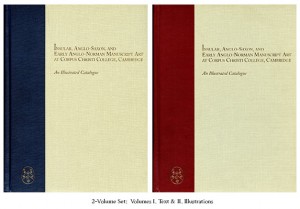 Some of the manuscripts on the table at the seminar figure in the Illustrated Catalogue of Insular, Anglo-Saxon, and Early Anglo-Norman Manuscript Art at Corpus Christi College, Cambridge (2 volumes, 1997) emanating from the long-term, integrated research work on selected Anglo-Saxon and related manuscripts at The Parker Library of Corpus Christi College, Cambridge. (The stages of the research work are recorded, for example, in the Annual Reports to the Leverhulme Trust, described in our Publications.)
Some of the manuscripts on the table at the seminar figure in the Illustrated Catalogue of Insular, Anglo-Saxon, and Early Anglo-Norman Manuscript Art at Corpus Christi College, Cambridge (2 volumes, 1997) emanating from the long-term, integrated research work on selected Anglo-Saxon and related manuscripts at The Parker Library of Corpus Christi College, Cambridge. (The stages of the research work are recorded, for example, in the Annual Reports to the Leverhulme Trust, described in our Publications.)
The manuscripts are:
- MS 44 = Budny Number 46 (The Corpus Canterbury Pontifical)
- MS 144 = Budny Number 6 (The Corpus Glossary)
- MS 197, Part B = Budny Number 3 (The Cambridge Portion of the Cambridge–London Gospels)
The Catalogue is now available through a Promotional Offer.
*****
So Long and Fare Well
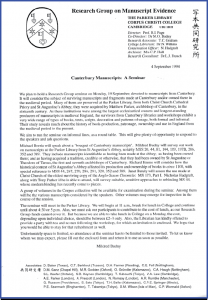 This was the penultimate Seminar in Series on the “The Evidence of Manuscripts” while the Research Group on Manuscript Evidence was in residence at The Parker Library and in England. The next Seminar in the Series considered, last but by no means least:
This was the penultimate Seminar in Series on the “The Evidence of Manuscripts” while the Research Group on Manuscript Evidence was in residence at The Parker Library and in England. The next Seminar in the Series considered, last but by no means least:
Canterbury Manuscripts
Parker Library, 19 September 1994
*****
Into the Future
A further Workshop, held by “The Parker Library, together with the Research Group on Manuscript Evidence”, took place at the Parker Library in the following year. Organised by Nigel Wilkins, it accompanied an exhibition on the subject and considered
Colours and Pigments in Manuscript Illumination
Parker Library, 9 June 1995
The Next Series
By then, in 1995, following the completion of the Research Project, and having to adapt to the change in plans accompanying the move to the United States in October 1994 (compare the activities at the 1994 Congress in May with the next institutional base as already contracted), the Research Group had determined not only to complete the remaining work of producing the Illustrated Catalogue (with the need to prepare unaided the camera-ready copy for the co-publisher), but also to adapt to the unexpected condition of having no institutional base for its next stage. A set of unilateral changes imposed upon the position itself at a late stage in Summer 1994 to the arrangements already contracted earlier in the year, to begin in the Autumn upon completion of the Project, made it necessary to reconsider and renegotiate, but in vain. By the time of the August 1994 Seminar, the change in direction was becoming manifest. A new home had to be sought at short notice, and so the vigorous momentum of our many activities in hand was disrupted decisively as regrouping had to begin afresh.
In stages following the move, the shape, sequence, and locations of the next scholarly events organised by the Research Group began to evolve. An essential component was — it still is — to find an institutional host for a given event, and then the speakers and, if possible, sponsors for it. Serendipity and the spirit of collegiality and generosity could, on auspicious occasions, come to the rescue.
Each time, it seems to require assembling an “ad hoc consortium” to produce a given event (apart from those, say, at an existing annual conference). Sometimes, happily, earlier host institutions and sponsors combine powers for renewed events, easing the path of preparation and accomplishment. And so the Events and the Seminars, Workshops, Colloquia & Symposia have continued. An eloquent description of the virtues of this approach (disadvantages are many) came in the “Concluding Remarks” by Giles Constable, an Honorary Trustee of the Research Group on Manuscript Evidence as a nonprofit educational corporation (1999–), at the 2016 Symposium on “Words & Deeds” at Princeton University. (See its Report.)
But these developments lay in the future, perseverance permitting.
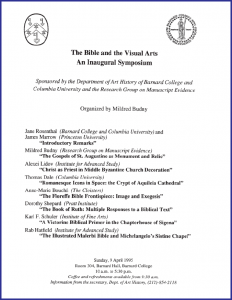 By March 1995, the first of the Symposia on “The Transmission of the Bible” took place, at the invitation of our Associate Jane Rosenthal, who had attended the Seminar on “Corpus Christi College MSS 23 and 223: The Corpus Prudentius and the Saint-Bertin Prudentius” at the Parker Library in June 1992. The response to the event by speakers, moderators, and audience made it clear that the practice was worth repeating. In turn, different institutions offered to host one of these Symposia, in a tour which circled from New York (Barnard College and Columbia University) to Princeton (University) to New Brunswick (Rutgers University) to New York (Fordham) and then again to Princeton and to New Brunswick.
By March 1995, the first of the Symposia on “The Transmission of the Bible” took place, at the invitation of our Associate Jane Rosenthal, who had attended the Seminar on “Corpus Christi College MSS 23 and 223: The Corpus Prudentius and the Saint-Bertin Prudentius” at the Parker Library in June 1992. The response to the event by speakers, moderators, and audience made it clear that the practice was worth repeating. In turn, different institutions offered to host one of these Symposia, in a tour which circled from New York (Barnard College and Columbia University) to Princeton (University) to New Brunswick (Rutgers University) to New York (Fordham) and then again to Princeton and to New Brunswick.
After that “Next Series” on “The Transmission of the Bible” (1995–2000), there commenced a New Series of Seminars, Workshops, Colloquia & Symposia (2001–), still in progress.
More Fragments for Consideration
Some of these meetings consider manuscript fragments in myriad forms. Among them are poignant cases of fragments, fragment collections, their challenges, and their potential.
- “Identity & Authenticity” (2013)
- “Recollections of the Past” (2014)
- “Words & Deeds” (2016)
and its Report
*****
So, too, our blog on “Manuscript Studies” (2015–) by Mildred Budny and others frequently addresses manuscript fragments in one form and another, with new discoveries for various types of manuscripts, texts, genres, and predicaments of disjointed transmission. The Contents List for the blog introduces the Menu of this Food for Thought on the nature of Manuscript (and Other) Fragments, starting with the post on “The ‘Foundling Hospital’ for Manuscript Fragments”.
*****
How fortunate to have the opportunity to examine closely various manuscript fragments, including some in the Takamiya Collection, in the company of a gathering of experts, students, and lovers of books, on a fine summer day in August 1994 at The Parker Library, along with some of its treasures, fragments included. And some of the participants included participants at another of our Seminars inspired by Toshiyuki Takamiya’s enthusiasm for medieval manuscripts, “scruffy” included, and for his students, colleagues, and friends:
- “Professionals’ Views of Manuscript Writing:
Calligraphic Techniques in Medieval Manuscripts and Their Modern Descendants”
Parker Library, 10 November 1993
We give thanks for such generosity.
Fragments and medieval manuscripts continue to fascinate. Much to explore, and much to learn, including from each other.
Join the discussion and let us know what you think!
*****
The next Seminar in the Series considered:
Canterbury Manuscripts
Parker Library, 19 September 1994
*****
Update in September 2017:
The Takamiya Collection has now moved to the Beinecke Library at Yale, where it finds a welcoming home. In 2017, this transfer yielded an impressive series of events and illustrated catalogue:
- an exhibition at the Library showcases highlights of this collection together with selected manuscripts in the Beinecke Rare Book and Manuscript Library: Making the Medieval English Book, on display from 1 September to 10 December 2017,
- an associated conference on 6–7 October 2017 focuses on the scope of the collection, with contributions by numerous experts (including some Associates of the Research Group on Manuscript Evidence, among them Toshiyuki Takamiya himself): Conference, and
- a published catalogue illustrates and describes the collection: Raymond Clemens, Diane Ducharme, and Emily Ulrich, A Gathering of Medieval English Manuscripts: The Takamiya Collection at the Beinecke Library (Beinecke Rare Book & Manuscript Library, Yale University, 2017).
It is a special treat to see both on display at the Beinecke and in the exhibition Catalogue the very Takamiya fragments which, with Toshi’s characteristic generosity, visited the Parker Library and served as focus for our 1994 Seminar on “Medieval Manuscript Fragments”. For example,
- the Deuteronomy fragment (from an early 8th-century Southern English, preserved also in a few leaves in Oxford and Salisbury) is Catalogue number 21,
- the Benedictional fragment (with part of the blessing for Easter Sunday) is Catalogue number 89, and
- the fragment with part of the Book of Judges (from the 8th-century Continental manuscript now called the “Werden Heptateuch”, known also from several other fragments spread through various collections) is Catalogue number 90.
These fragments are described and illustrated respectively Clemens et al., pages 36–37 and 42).
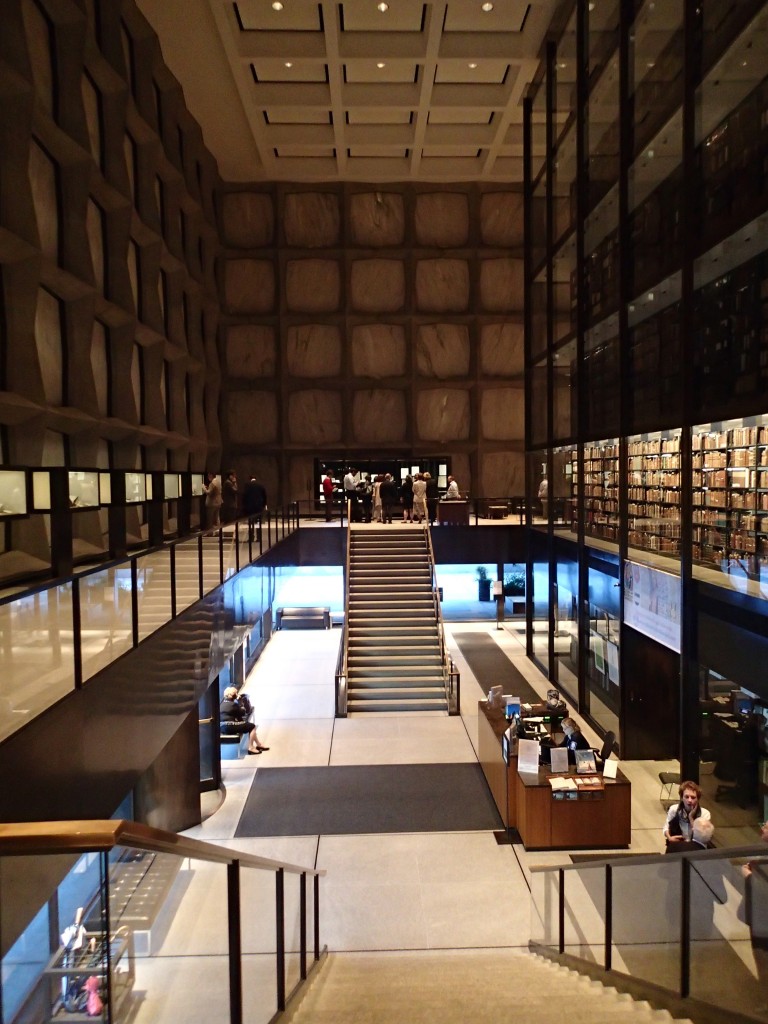
Long View of the Takamiya Collection Exhibition at the Beinecke Rare Book and Manuscript Library in September 2017. Photograph by Mildred Budny.
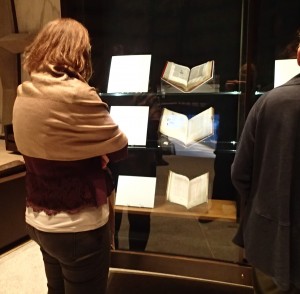
Case Study of the Takamiya Collection Exhibition at the Beinecke Rare Book and Manuscript Library in September 2017. Photograph by Mildred Budny.
We look forward to learning more from the Takamiya Collection Conference.
*****

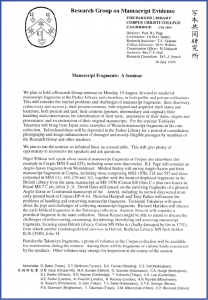
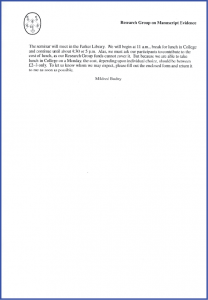
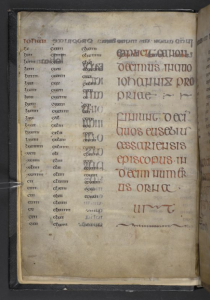

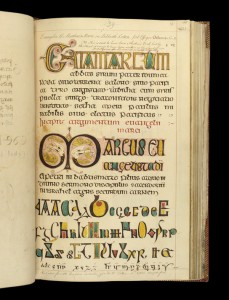


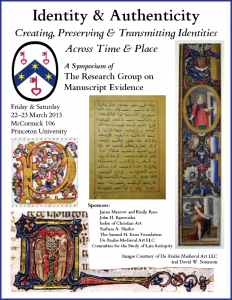
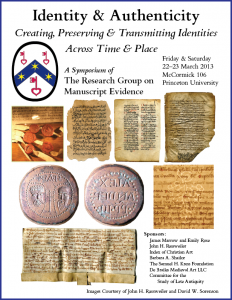
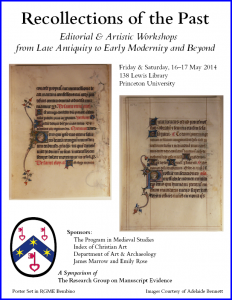
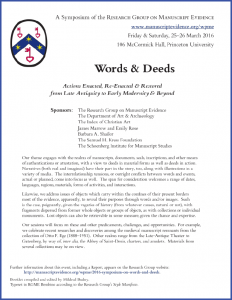
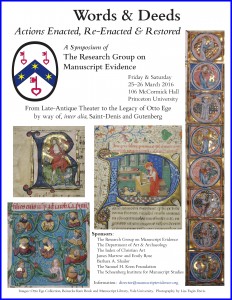
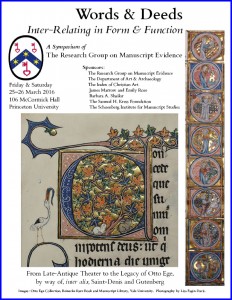
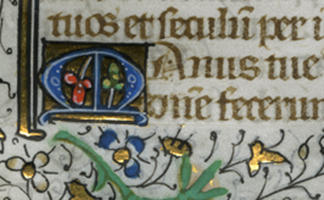
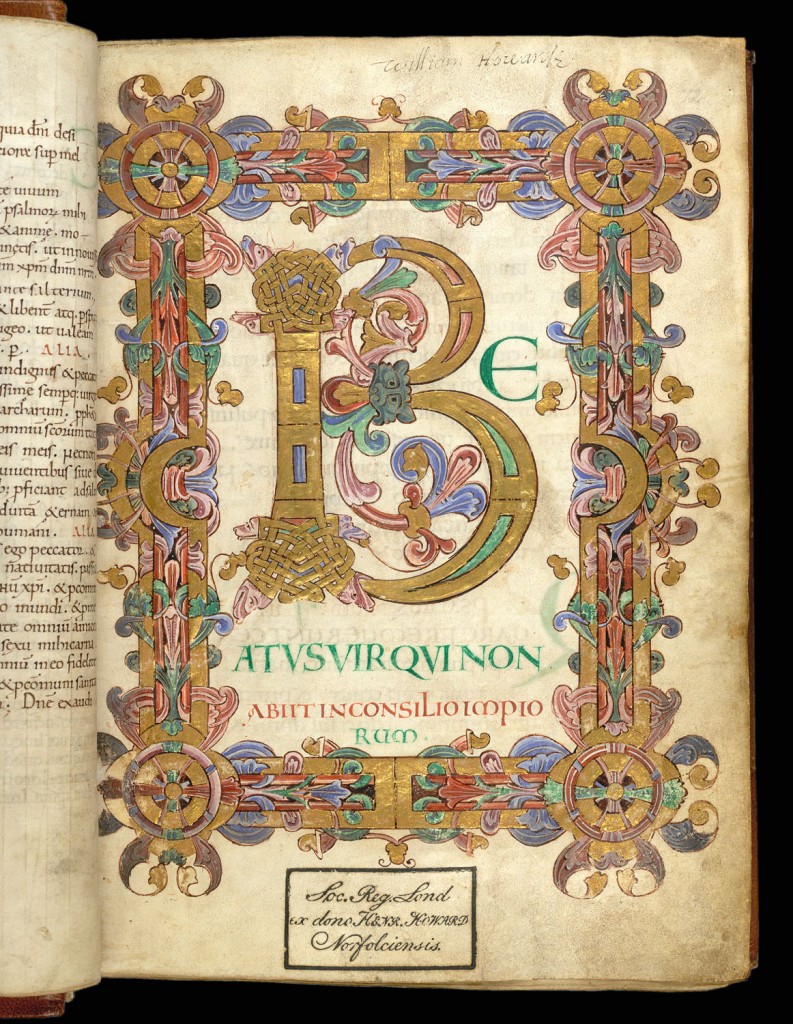
I must say it was hard to find your website in search results.
You write awesome posts but you should rank your page higher in search engines.
If you don’t know how to do it search on youtube:
how to rank a website Marcel’s way
33Joni recently posted…33Joni